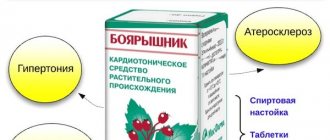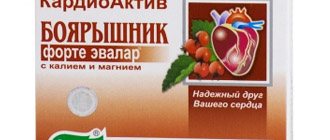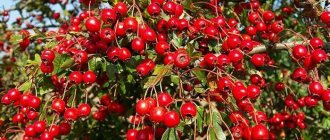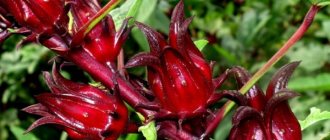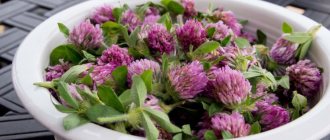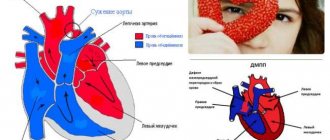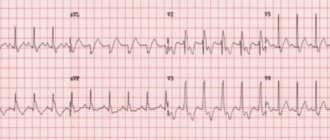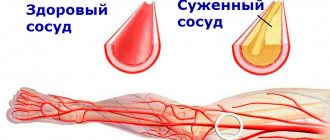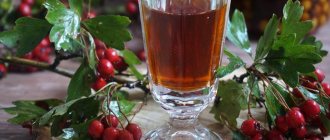Description
Hawthorn is a shrub or tree, up to 5 m high, from the Rosaceae family. Distributed in temperate latitudes of North America, Europe and Asia. The plant is very unpretentious and tolerates both frost and summer heat. Grows well both in the garden and in the forest. The shrub is extremely durable: it grows up to 400 years.
Hawthorn is grown for its medicinal properties and decorative properties. The shrub is multi-stemmed, with a dense crown, and holds its shape well. Hawthorn blooms profusely and produces many small bright red fruits. Against the background of green foliage, both berries and flowers look very decorative.
Since the 16th century, decoctions and infusions of the shrub's leaves have been used to treat dysentery and other forms of diarrhea. Later, the blood purifying properties of hawthorn became known. In the 20th century, the fruits, leaves and flowers of the plant were used to treat diseases of the heart and blood vessels.
Chemical composition
The composition of the fruits, shoots and flowers of hawthorn is very rich from the heart:
Vitexin – increases the elasticity of the walls of blood vessels. They expand, transport blood more actively, which facilitates the work of the heart and improves the blood supply to the organ;
hyperosiod – stimulates myocardial contractility. At the same time, the release of blood increases when the ventricles contract, that is, to maintain the same level of blood pressure, the heart beats slower. Hyperoziod stimulates the oxidation of glucose, which helps saturate cells with energy;
quercetin – affects blood circulation;
quercetrin – reduces the permeability of capillary walls and also acts as an antioxidant;
organic acids - the fruits and flowers of hawthorn contain both ordinary substances, such as citric or malic acid, and compounds that have a beneficial effect on the functioning of organs. Thus, caffeic acid stimulates the production of bile and suppresses the proliferation of pathological microflora. Ursolic acid provides the anti-inflammatory effect of hawthorn, chlorogenic acid normalizes the functioning of the kidneys and liver, oleanolic acid improves blood supply to the brain and heart;
vitamins - hawthorn for the heart is known as a record holder for the content of vitamin C. Decoction and tea from the berries improves immunity and significantly speeds up recovery from colds, sore throats, sore throats, and bronchitis. Also in the leaves and flowers there are vitamins A, E, K;
microelements - potassium, calcium, manganese, zinc and others. The most valuable component is iron.
The content of active substances in different parts of the plant is different. The fruits contain more organic acids and esters - for heart disease, drugs are prescribed mainly from berries. The fruit seeds contain astringents, which are used to treat diarrhea. For vascular pathologies, tea or a decoction of the leaves will be most useful, as they contain more vitexin. Flower tea has a general strengthening effect because it contains many flavonoids and acids.
Hawthorn root is used as a component of anti-aging products. It is rich in vitamins and polysaccharides.
A healthy lifestyle as a way to prevent arrhythmia
To maintain health, you should give up bad habits; they have a very negative impact on the functioning of the cardiovascular system. Moderate physical activity, which strengthens the immune system and improves heart function, has a positive effect. Walking in the fresh air, jogging, breathing exercises, swimming, skiing and other gentle sports are especially useful. Healthy, complete sleep and rest, and adherence to a daily routine are very important for the prevention of arrhythmia. You also need to pay attention to the state of the nervous system and psycho-emotional state. Frequent stress and autonomic disorders contribute to the appearance of cardiac pathologies. Avoid conflict situations, stress, excessive mental stress, maintain peace of mind and calm.
Contraindications
Although the berries and flowers of the plant are used to treat heart disease, taking the drugs is prohibited for certain pathologies. A few disappointments:
- angina pectoris against the background of high blood pressure - the ability of hawthorn to slow down the rhythm of contractions only brings harm;
- severe forms of heart failure - the patient’s condition is very unstable and the effect of hawthorn becomes unpredictable;
- severe kidney pathologies - emerging disturbances in the excretion of organic acids lead to a deterioration in the patient’s condition;
- It is strictly forbidden to use hawthorn for the heart if you are allergic to any component of the drug.
The use of tincture is more limited, since it contains alcohol. In this form, hawthorn for the heart is prohibited from being used during pregnancy, breastfeeding, or with arrhythmia. Of course, children under 14 years old should not drink the tincture.
Interesting! Myocardial infarction is not a contraindication for taking the medicine. The decisive factor in treatment is the relative stability of the patient’s condition.
Collection and procurement of raw materials
At home, preparations based on fruits and flowers are more often used.
The inflorescences are collected during flowering. Only those flowers that have fully opened are selected. They are collected during the day, after the dew has completely disappeared. In rain or cloudy weather, the collection is canceled. To dry, flowers are laid out on paper in a dark, well-ventilated place.
The fruits are picked in October, when they are fully ripe. Hawthorn berries are washed and dried in the oven at a temperature of about 50 C. The oven door is not closed. The fruits are considered ready when they darken.
Dry raw materials should be stored in paper or canvas bags. Berries can be frozen for long-term storage. The shelf life of the prepared product is 2 years.
Recipes
For treatment, they use both pharmaceutical preparations - drops, tinctures, and self-prepared ones. The recipes are very simple, and hawthorn grows everywhere. Tinctures and decoctions of the plant are recognized as official medicine, so herbal medicines of this kind are prescribed by a doctor.
Be sure to consult a specialist before use. The active substances of hawthorn may conflict with other medicinal drugs.
Tea
The most popular form of taking hawthorn for the heart is tea. It’s easy to prepare: 20 berries are poured into 1 liter of boiling water and left in a thermos for 6–8 hours. Chamomile, rose hips - fruits or leaves, motherwort or valerian are also added to tea.
A drink with the last 2 ingredients is drunk at night, as it has a calming and mild hypnotic effect.
Tincture
The tincture can be prepared with either water or alcohol. The first ingredient is used in the treatment of both children and adults, the second is intended only for patients over 14 years of age.
You need to prepare the tincture in water like this: pour 50 g of berries with a glass of hot water - with a temperature of 70–80 C, and leave for 30 minutes. You can prepare the medicine in a thermos: brew a tablespoon of hawthorn flowers with 250 ml of boiling water and keep in the thermos for 3-4 hours. The product differs from tea in a higher concentration.
To make an alcohol tincture you need 70% alcohol or good vodka. 1 part of crushed berries is poured with 10 parts of alcohol, or 2 parts of dried flowers are combined with the same volume of alcohol. Infuse the fruits and inflorescences for 2 weeks in a dark place. The tincture should be used carefully: no more than 100 drops at a time. Add it to tea or water.
Important! Exceeding the dose is fraught with serious complications.
Decoction
Decoctions are prepared in a water bath. 3 tablespoons of raw materials are poured into ½ liter of boiling water. Place the container in a water bath and boil the liquid for 20 minutes. After cooling, the broth is filtered. It should be taken in the same way as a tincture of water.
The beneficial properties of decoctions are not inferior to the qualities of tinctures, but it can be prepared not only from flowers and berries, but also from bark, leaves, and shoots. This method allows you to extract medicinal substances from the roughest parts of the bush.
Juice
Juice is prepared from fresh berries. 200 g of fruits are cut into small fragments, mixed with 100 g of water and heated to 40 C. It is better to boil in a water bath. The resulting liquid is filtered and drunk 50 g before meals 4 times a day.
The berries remaining after obtaining the juice can be used to prepare a decoction.
Weight correction as arrhythmia prevention
Excess weight is considered a predisposing factor to the development of many diseases. Obesity significantly increases the likelihood of arrhythmia, so you need to keep your body weight within normal limits and, if necessary, adjust it. To get rid of extra pounds, you need to adhere to a proper balanced diet, lead an active lifestyle, and give up bad habits. Phytotherapy
Additional stimulation with natural substances, without the use of drugs, is an excellent prevention of arrhythmia.
Infusions and decoctions of the following herbs have a good effect on the cardiovascular system:
- calendula;
- valerian;
- yarrow;
- Melissa;
- chicory;
- hawthorn;
- motherwort;
- mint, etc.
Such herbal teas have a calming effect. If there is a need for diagnosis or treatment of arrhythmia, Turkish clinics provide high-quality medical services at affordable prices.
Application
Heart failure develops slowly. Its symptoms in the initial stages are mild. In essence, the disease is associated with a weakening of the heart muscle: it stops contracting strongly enough. The heart cannot pump enough blood, which leads to chronic starvation of organs and tissues, including the heart itself.
The use of hawthorn for the heart is based on its stimulating properties. Hyperoziod and other glycosides activate the myocardium, which increases the functionality of the heart. Organic acids and vitexin stimulate blood circulation by increasing the elasticity of the walls of blood vessels.
The third stage of action is toning the heart muscle. For normal functioning of the latter, complete oxidation of glucose is necessary, since in this case the cell receives 18 times more energy than during glycolysis. The heart muscle needs a lot of oxygen. Improving blood circulation and achieving complete oxidation of glucose is the best way to restore the heart.
Improves blood clotting
The blood purifying properties of hawthorn have been known for a long time. It is prescribed when there is a change in the normal number of platelets in the blood, that is, when there is a danger of both thrombus formation and excessive blood thinning. The complex of active substances of the plant normalizes the amount of formed bodies in the plasma and restores normal coagulation.
To thicken the blood, hawthorn is used for many systemic diseases that lead to changes in hemodynamics. The herbal medicine is most effective for diabetes mellitus.
Increases blood oxygen saturation
Hawthorn fruits and flowers for the heart contain a lot of iron and flavonoids. These substances stimulate the production of red blood cells - red blood cells and hemoglobin. Since oxygen is transported by hemoglobin molecules, as they increase, the supply of oxygen to the heart improves.
Hawthorn tea and tincture are useful for iron-dependent anemia, after an illness, after blood loss.
Important! The therapeutic effect of the plant manifests itself quite quickly: shortness of breath caused by a lack of oxygen in the blood disappears.
Reduces blood pressure
The effect of hawthorn on blood pressure is ambiguous. Its ability to lower blood pressure is better known. The composition of the herbal medicine includes hyperoziod: it improves myocardial contractility and increases the sensitivity of muscles to nerve impulses and the action of glycosides. Normal, load-appropriate work of the myocardium allows you to reduce the number of contractions due to a stronger release and movement of a large portion of blood. This reduces the pressure.
To reduce pressure, hawthorn is combined with motherwort, chokeberry, and cucumber. All ingredients are mixed in equal parts, then 1 part of the raw material is poured with 20 parts of water. Infuse the drug for 8–10 hours in a thermos. Drink 1/3 glass of infusion before meals.
If high blood pressure is associated with kidney failure, use a recipe made from hawthorn and rose hips. Equal shares of the fruit are brewed with boiling water and left for at least a day. The decoction has a pronounced diuretic effect.
To increase blood pressure, an alcoholic tincture of hawthorn is mixed with decoctions or tinctures of lemongrass, ginseng, and eleutherococcus. Drink 20–30 drops of the drug in half a glass of clean water.
Restores the conductivity of cardiac impulses
Normal cyclic heart function involves sequential contraction of the atria, ventricles and pause. An important sign of organ health is the complete and simultaneous contraction of muscle fibers. This effect is possible when all fibers receive the same impulse at the same time.
However, as the heart wears out, the conductivity of impulses in the fibers becomes different. As a result, some of them contract stronger, some weaker, and some are delayed. This is how arrhythmia is formed.
Hawthorn for the heart includes a complex of substances that solve this problem. First of all, it is a hyperosiod - a substance that improves the conductivity of nerve impulses. A large amount of potassium, calcium and magnesium ions ensures the normal functioning of the calcium pump. Vitamin E and carotene prevent the appearance of tumors.
Restoring conduction not only normalizes heart function, but also helps people suffering from migraines. When consuming hawthorn, the “hyperreaction” effect disappears, which reduces the time and frequency of attacks.
Strengthens brain vessels
Hawthorn for the heart and blood vessels is known for improving blood supply to the brain. Triterpene acids increase blood circulation in the coronary vessels and in the vessels of the brain. Quercetin and polyphenolic complexes reduce the permeability of the walls and also strengthen the veins and arteries of the organ.
The herbal medicine is prescribed for prolonged migraines, severe headaches that occur due to stress and fatigue. For treatment, tea is prepared from equal parts of hawthorn and St. John's wort. Drink the drink three times a day after meals. Tea with honey is consumed at night, as it relieves irritability and fatigue.
To strengthen blood vessels
Hawthorn strengthens blood vessels not only in the brain or heart. Vitexin, which is part of the herbal medicine, increases the elasticity of capillary walls, and quercetin reduces their permeability. In combination, these substances are so useful that when drinking tincture or tea of the plant, the manifestations of varicose veins and hemorrhoids are reduced.
For vessels, the following recipe is recommended: 3 tablespoons of dried flowers and the same amount of pharmacy caps are poured into 1/2 liter of water. Boil and leave in a thermos for 4–6 hours. Drink 100 ml before lunch and dinner.
Important! Consumption of fruits and vegetables rich in vitexin, as well as hawthorn decoction, reduces the likelihood of myocardial infarction by 4 times.
Reduces the likelihood of atherosclerosis
Atherosclerosis is the result of the formation of cholesterol plaques on the walls of blood vessels.
Of course, to treat the disease it is necessary to take drugs that change the blood lipid profile. But the course of therapy also includes hawthorn as an additional remedy. Organic acids help break down cholesterol compounds into simple fats, thereby preventing the appearance of deposits. The disappearance of plaques leads to an increase in the working diameter of the vessels, preventing blockage even with a tendency to thrombus formation. Hawthorn for the heart helps restore normal blood circulation.
Hawthorn for rhythm disturbances
The herbal medicine has a complex effect on various heart diseases. Arrhythmia occurs when impulse transmission is disrupted: the ventricles and atria contract at different rates. Hawthorn improves conductivity, thereby normalizing the rhythm of contractions.
The drug is effective for both tachycardia and extrasystole. In the first case, the heart rate increases sharply, mainly due to lack of oxygen. The heart tries to accelerate blood circulation as much as possible so that the body tissues receive enough oxygen. Since hawthorn restores hemoglobin, this need disappears.
Extrasystole occurs for the same reasons as arrhythmia. Improving sensitivity to sinus node signals normalizes heart rhythm.
Hawthorn for heart attack
The cause of heart attack in most cases is high blood pressure and atherosclerosis. Decoctions and infusions of the plant lower blood pressure and prevent the appearance of cholesterol plaques, thereby becoming an excellent preventive measure.
Hawthorn also helps after a heart attack: it improves the functioning of the heart muscle and stimulates blood circulation. For treatment, you need to take berry juice with a teaspoon of vegetable oil twice a day. Later, the juice is replaced with a decoction.
Hawthorn for stenosis
The herbal medicine helps break down cholesterol compounds into fats. And chlorogenic acid in berries and flowers stimulates the liver, where the breakdown process occurs. Thus, hawthorn prevents stenosis.
When narrowing blood vessels, prepare a concentrated decoction or infusion of water. Another option is a complex collection of 50 g of heather, wheatgrass roots, ½ cup of hawthorn, horse chestnut and birch leaves. All ingredients are crushed, 1 teaspoon of the mixture is poured with a glass of boiling water and left for 20–30 minutes. Drink ½ glass in the morning and before bed.
Hawthorn for ischemia
With the general inelasticity of oxygen in the blood, the environment is particularly affected. For its normal functioning, a large volume of oxygen is required. Ischemia quickly leads to tissue dysfunction, dysfunction, and heart attack.
The treatment is as follows: 3 tablespoons of hawthorn and motherwort flowers are poured into 3 cups of boiling water and left for 20 hours. The infusion is drunk in 3 doses per day.
Hawthorn: beneficial properties and contraindications
Hawthorn has many beneficial properties and is often used for disease treatment and preventive measures.
There are many legends about the origin of hawthorn. According to one of them, the hawthorn appeared at the request of small birds for protection from predators. The thorns of this bush allow small birds to hide, but large birds cannot overcome such a barrier.
hawthorn photo
According to another legend, in Rus' the lady was famous for her good deeds - she helped everyone she could. Some with treatment, some with just advice. But no one is eternal. The lady grew old, but she really didn’t want to die. I really wanted to continue helping people. And people loved her. Let's go to the witch with a bow. She turned the old woman into a beautiful bush. And it received the appropriate name - hawthorn. So she continued to help. In addition, hawthorn lives for a very long time.
Be that as it may, whatever the true origin of this plant, hawthorn has long been loved for its healing properties and beauty - the type of blood-red variety of hawthorn still attracts attention. And the people began to give it their own names: boyarka, lady, glod. And for its thorns it is called “cock’s spur” or “hawk’s claws.”
Hawthorn was of particular importance in ancient times. Greek myths dedicated it to Hymen, the god of family and marriage. Girls getting married decorated their heads with hawthorn wreaths. King Richard III of England found his crown on this bush, after which the hawthorn became his emblem.
There are many beliefs associated with this plant. Many peoples believed that hawthorn had magical properties, which it owes to its thorny branches. They were believed to protect against evil spirits. In Ancient Greece, hawthorn branches were hung above the entrance to a home so that no evil spirits could penetrate inside. According to the Romans, hawthorn branches in infants' cradles warded off the devil from them. When casting spells over a sick child in Buryatia, they used hawthorn and rosehip, waving their branches over the cradle.
But there were also opposing opinions. For example, Celtic tribes and Moldovans personified this plant with darkness and evil. They even believed that hawthorn was to blame for all tumors and abscesses on the legs.
All this did not prevent healers and witches from treating many diseases with hawthorn, using it to prepare potions and potions. They kept their recipes secret. So, in herbalists and medical books, information about the benefits of hawthorn and what can be made from hawthorn appeared centuries later.
But with the coming to power of Peter I, hawthorn became widespread, and the medicinal properties of hawthorn began to be used at the state level. Hawthorn is grown in specially open apothecary gardens. And the peasants were obliged to collect hawthorn fruits as a duty.
Appearance of hawthorn
blood red hawthorn
Nowadays, hawthorn is spread all over the world - its beneficial properties are widely known and actively used. Some types of hawthorn are recognized by official medicine. Among them: hawthorn single-pistillate, prickly, blood-red, green-fleshed, Altai, bent-calyx, smooth. In total, there are about 1,250 species of hawthorn in the world, fifteen of which grow in Russia. Moreover, different types differ from each other both in appearance and in useful properties.
Therefore, it is definitely very difficult to say what hawthorn looks like. But, of course, there are similar types. Hawthorn is also used as an ornamental plant, as it is distinguished by its exceptional beauty. In autumn, the dense, rounded crown with graceful leaves turns orange and red. Small white or dark pink flowers bloom in spring. True, they bloom for only a few days and do not have a very pleasant smell. And hawthorn fruits decorate the plant for two months. They can be oblong or spherical, with one or more bones. Their color can also be different. There is hawthorn black, red, orange, yellow.
Different species differ in the presence or absence and length of spines. For example, the blood-red rose hip has almost no thorns. And those that exist are not very long. But large-fruited hawthorn, on the contrary, protects its berries with very impressive thorns, sometimes reaching 12 centimeters.
Thanks to the existing thorns and dense crown, hawthorn is successfully used as a hedge. If such a hedge is properly cared for, it is almost impossible to overcome it.
Beneficial properties and medicinal use
homemade hawthorn tincture
But, of course, hawthorn has more than just decorative uses. Hawthorn is an extremely useful plant. The healing properties of hawthorn have long been widely used in the treatment and prevention of many diseases.
The medicinal properties of hawthorn are based on its composition. Hawthorn fruits contain a large amount of flavonoids, pectin and tannins. Among the microelements, copper, zinc, iron, potassium, phosphorus, calcium, magnesium, cobalt, and molybdenum can be identified in hawthorn. Well, in addition, hawthorn contains vitamins C, P, carotene, thiamine, choline, riboflavin.
And, after all, hawthorn also has great nutritional value. It contains organic acids. Mainly apple, lemon and amber fatty oils. It also contains a sufficient amount of sugars, the basis of which is fructose. Thanks to this, you can use hawthorn for diabetes.
All pharmacies sell hawthorn tincture. It is made from the fruits of blood-red hawthorn and 70% alcohol. Hawthorn tincture is used to improve the functioning of the central nervous system, tachycardia, and atherosclerosis. Hawthorn tincture normalizes blood pressure if it is high. It is also useful during menopause.
Hawthorn tincture at home is quite easy to prepare. Moreover, you can prepare a tincture from both the fruits and flowers of hawthorn. In the first case, 25 gr. You need 100 grams of fruit. alcohol This tincture is taken 30–60 drops three or four times a day.
In the second case, take two parts of alcohol for one part of the flowers. The mixture is infused for fifteen days. It is taken three times a day, forty drops.
Also, in addition to alcohol tincture, hawthorn tincture with vodka is also used. Someone may be interested in the question of how to prepare hawthorn tincture with vodka. To do this, a spoonful of fruits or flowers is infused in a closed container of 200 ml. vodka for seven days.
But, of course, hawthorn tincture also has contraindications, although they are few. So, you should not use it if you have hypersensitivity to any component. And of course, due to the alcohol content, it is contraindicated for pregnant women and children.
Not only hawthorn fruits have beneficial properties. Flowers, leaves, and shoots are also widely used.
Since the 16th century, hawthorn has been used as a tonic for dysentery and diarrhea. A large amount of pectin helps get rid of heavy metal salts and other harmful substances, lowers cholesterol levels in the blood, and reduces lipid deposits in organs due to atherosclerosis.
hawthorn has a positive effect on the heart and blood vessels
But the main benefit of hawthorn is its positive effect on the heart and blood vessels. By the way, during World War II, hawthorn was used instead of medicines for heart diseases.
Hawthorn is useful for the heart in various disorders of its activity and manifestations of weakness of this organ. Hawthorn is prescribed after serious illnesses. It will also help during hypertension, angioneurosis, hyperthyroidism, and eliminate tachycardia and arrhythmia. Hawthorn tones the heart muscle and increases blood circulation in the coronary vessels. At the same time, hawthorn selectively expands the blood vessels of the brain, as well as the coronary vessels. This property allows the use of preparations based on hawthorn in a targeted manner. This helps supply oxygen to the myocardium and neurons of the brain.
Hawthorn will relieve unpleasant and painful sensations in the heart area and improve overall condition.
Traditional medicine recommends using hawthorn if there are edema associated with the work of the heart, with rheumatism, epilepsy. And besides this, there is reason to believe that hawthorn also treats various nervous diseases that are accompanied by pain. Hawthorn fruits have properties that allow them to improve the activity of the mammary glands.
hawthorn helps relieve stress
It helps reduce the bioelectrical activity of the cerebral cortex and calms the nervous system. The sedative effect of hawthorn has been experimentally proven. Also, with increased thyroid function, hawthorn preparations will be useful. They also increase bile secretion.
Due to its antispasmodic effect, hawthorn is also used for headaches, pain in the lower back, shoulders, shoulder blades, dropsy, and blood diseases. It is effective for diseases of the gallbladder, liver, renal colic and intestinal disorders. Frequent urination and small amounts of urine also become an indication for the use of hawthorn. Helps during fever, as well as in the fight against the herpes virus.
And in case of poisoning, antitoxic tea, consisting of rose hips and hawthorn, roots of Baikal skullcap, elecampane, and tansy flowers, helps very well. A mixture of rose hips with other herbs also helps during suffocation and nervous shock.
In different countries, hawthorn is used to treat various diseases. Thus, in Western European countries, hawthorn is prescribed for urolithiasis, sore throat, menorrhagia, and dysentery. In Belarus, it is used for stomach and duodenal ulcers, diseases of the esophagus, osteoalgia, asthma, and dermatomycosis. But in Siberia it is used to treat gynecological diseases. Recently, the antitumor effect of hawthorn has been studied. Its use has been found to be effective in treating leukemia.
Hawthorn during pregnancy
hawthorn is useful for pregnant women, but it must be used carefully
Expectant mothers are interested in whether hawthorn can be used for pregnant women?
This issue becomes relevant, since most medications are prohibited during this period. It’s even better to consult your doctor first. Hawthorn is useful during pregnancy as part of a soothing tea. In this case, it is important to know how to brew hawthorn correctly. Its concentration should be small. Then it will have a beneficial effect on the nervous system of a pregnant woman, help with insomnia, and will not have negative consequences.
Here is another healthy drink recipe for expectant mothers.
For it you need to take one tablespoon of concentrated hawthorn infusion, two tablespoons of kefir or yogurt, half a teaspoon of honey and one banana. Next, all components are mixed and whipped into foam.
Harm from hawthorn
use of hawthorn for hypotension
You should not overuse a berry like hawthorn - oddly enough, it also has contraindications. Long-term and excessive use of drugs with hawthorn leads to too strong a decrease in blood pressure and heart rhythm disturbances. Accordingly, hypotensive people should take hawthorn extremely carefully - their blood pressure is already low. Hawthorn decoction, like its infusion, should not be drunk on an empty stomach. Otherwise, intestinal spasm, vomiting or vasospasm may occur.
Of course, it is necessary to consume hawthorn in moderation - then the benefits and harm will simply not be comparable. In this regard, questions logically arise about how to use hawthorn and what can be prepared from hawthorn. In fact, there can be a lot of options.
For hypertension and neuroses, prepare a hawthorn infusion:
To do this, you need a mixture of four parts of hawthorn fruit, the same amount of motherwort and one part of chamomile. One tablespoon of this mixture is poured into one glass of boiling water. This is infused for two hours. You need to take a tablespoon three times a day.
Also popular among drinks is hawthorn tea, made from its berries and leaves.
Hawthorn in cooking
dishes with hawthorn are tasty and healthy
Hawthorn fruits are also used in the confectionery industry. The dried berries are often ground and added to flour for baking cookies and muffins. Hawthorn gives the dough a pleasant fruity flavor. And if you mix ground fruits with honey you will get an excellent filling for pies.
Hawthorn berries will retain their beneficial properties even after making jams, marmalades, jelly, and juices from them. By the way, hawthorn flowers are honey-bearing. From one bush you can sometimes get up to twenty kilograms of honey.
But not only dishes made from hawthorn are tasty and healthy. Oddly enough, alcohol can also be beneficial. Or rather, hawthorn wine. It has a beneficial effect on both men and women who are already forty years old. Avicenna noticed this in his time. And it is prepared like this:
Finely crushed hawthorn fruits are poured with 2 liters of natural white wine. After ten days it needs to be strained. During this time, you need to shake the jar with its contents several times a day. Basically, the wine is ready. But you can also add raisins, cinnamon, yarrow, honey and, of course, hawthorn flowers to it during the cooking process.
And, of course, you can eat fresh hawthorn - no recipes needed here. It is important to collect hawthorn - everyone knows how to use it.
How to collect and preserve hawthorn
dried hawthorn can be stored for more than one winter
But in order for the question of what to cook from hawthorn not to arise in vain, that is, for the hawthorn to really show all its beneficial properties, you must first of all ask yourself the question of how to collect it and how to store the hawthorn.
Flowers should be collected at the very beginning of flowering. They must be dry at the same time. If you collect them after rain or dew, the flowers will simply rot. The fruits are harvested only when fully ripe. By the way, after frost they lose some of their tannins and become sweeter.
Drying hawthorn proceeds as follows: the collected fruits are scattered in a thin layer on a baking sheet and it is placed in a heated, but not too hot oven. Periodically, the fruits are mixed and burnt berries are removed. Dried hawthorn is stored in plywood boxes or bags. Hawthorn harvested in this way for the winter, by the way, even for more than one winter, will retain all its beneficial properties.
There are about 50 species of hawthorns in our country and they grow everywhere except the Far North. We will focus on three species: blood-red hawthorn (Grataegus sanguinea Pall.), prickly hawthorn (Grataegus oxyacantha L.) and pentaegus hawthorn (Grataegus pentagyna).
The healing properties of hawthorn fruits and flowers have been known to man for a long time. Our ancestors used them for palpitations, insomnia, and high blood pressure. In the East, hawthorn was called the “wild apple tree”: the hawthorn tree really looks like an apple tree, especially with its leaves and roots. This was noted by Avicenna, who wrote that hawthorn “knits stronger than rowan, suppresses bile and blocks the flow more strongly than any other fruit.”
Avicenna believed that hawthorn was harmful to the stomach, it “locks the stomach and does not retain urine.”
The German doctor Jening noted back in 1896 that hawthorn has a positive effect on heart diseases, increases heart contractions and has a calming effect on the central nervous system. Some doctors achieved complete cessation of attacks of pain due to angina pectoris by giving patients hawthorn preparations.
Hawthorn is widely used in folk medicine. It has been established that it increases blood circulation in the vessels of the heart and brain, has an anti-atherosclerotic effect, drugs made from it are used for various diseases of the cardiovascular system in elderly and senile people, especially for diseases of the menopause, atherosclerosis and cardiac neuroses.
At the same time, the absence of any toxic effect during long-term use of hawthorn preparations allows them to be prescribed even to patients with impaired renal function.
Taking hawthorn preparations gives positive results in the early stages of hypertension, while the vasodilating and antispasmodic effects of hawthorn play a role.
Hawthorn preparations are especially often used for heart muscle fatigue. They selectively dilate coronary vessels (and blood vessels of the brain), reduce the excitability of the nervous system, increase the supply of oxygen to the heart and brain, improve metabolism in the body, normalize heart rhythm, eliminate discomfort in the heart area, normalize sleep and general condition, and help speed up recovery after serious illnesses and lowering blood cholesterol levels.
A positive effect from taking hawthorn preparations is observed for dizziness, shortness of breath, and insomnia.
Hawthorn is not contraindicated during pregnancy.
Our ancestors prepared a decoction from hawthorn bark and its branches to dye fabrics red.
